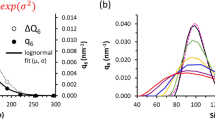Abstract.
The inherent variability of morphological and physiological parameters can cause significant statistical variations in the deposition patterns of inhaled particles in the human lungs. From a dosimetric point of view, the two major sources of variability are (i) the statistical distribution of particles deposited among all airways in a given generation, caused by the biological variability of the lung structure, and (ii) the local distribution of particles deposited within a given airway bifurcation resulting from the inhomogeneity of flow patterns and associated deposition mechanisms. Due to the stochastic nature of particle transport within the lungs in general, and within airway bifurcations in particular, this variability can be described mathematically by stochastic models. In addition to average values, stochastic models also provide information about the statistical distributions of deposition patterns, reflecting intra- and intersubject variability in particle deposition.
Similar content being viewed by others
Author information
Authors and Affiliations
Rights and permissions
About this article
Cite this article
Hofmann, W. Stochastic dose estimation for inhaled particulates. Stochastic Environmental Research and Risk Assessment 14, 181–193 (2000). https://doi.org/10.1007/s004770000037
Issue Date:
DOI: https://doi.org/10.1007/s004770000037




